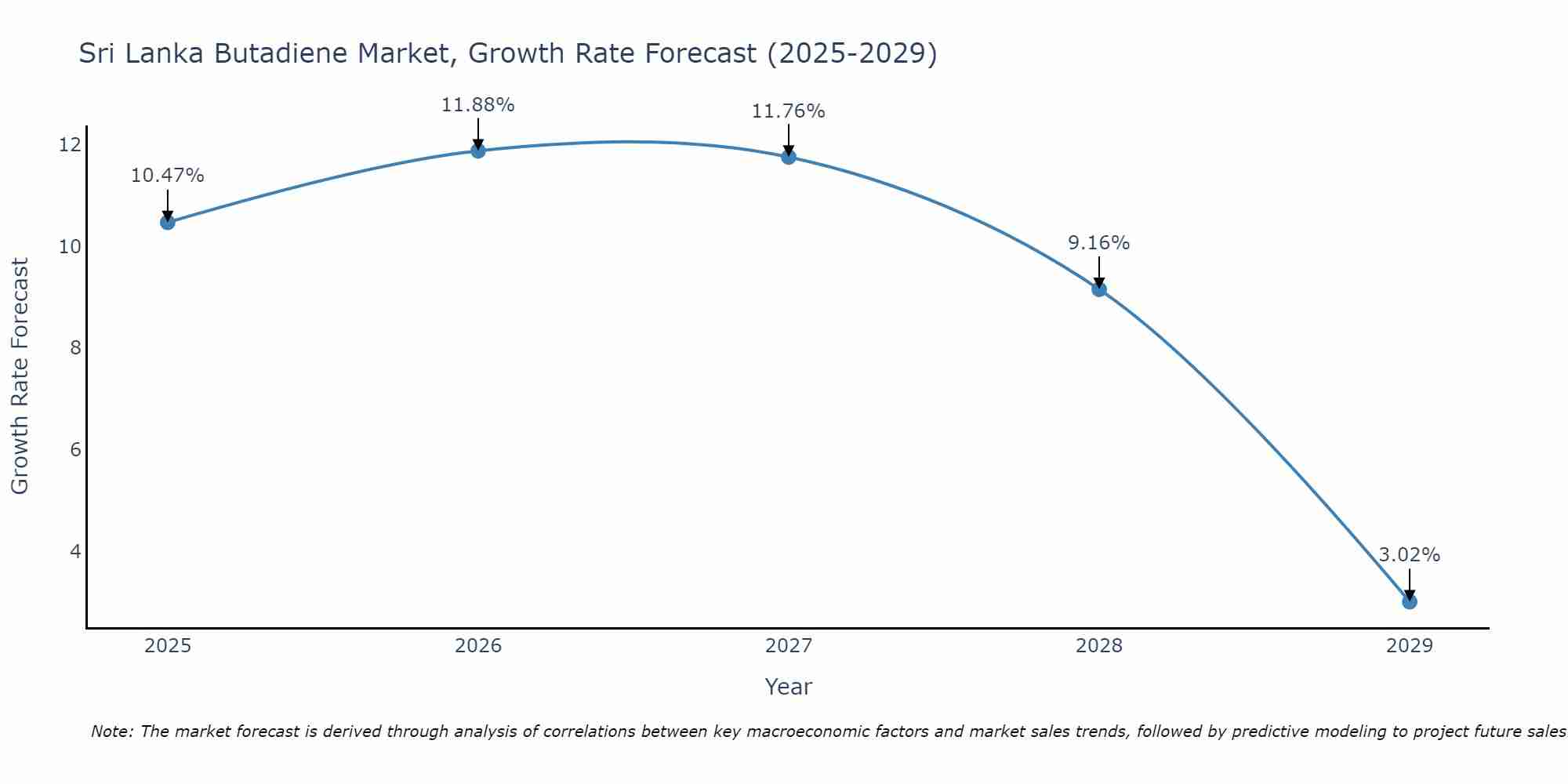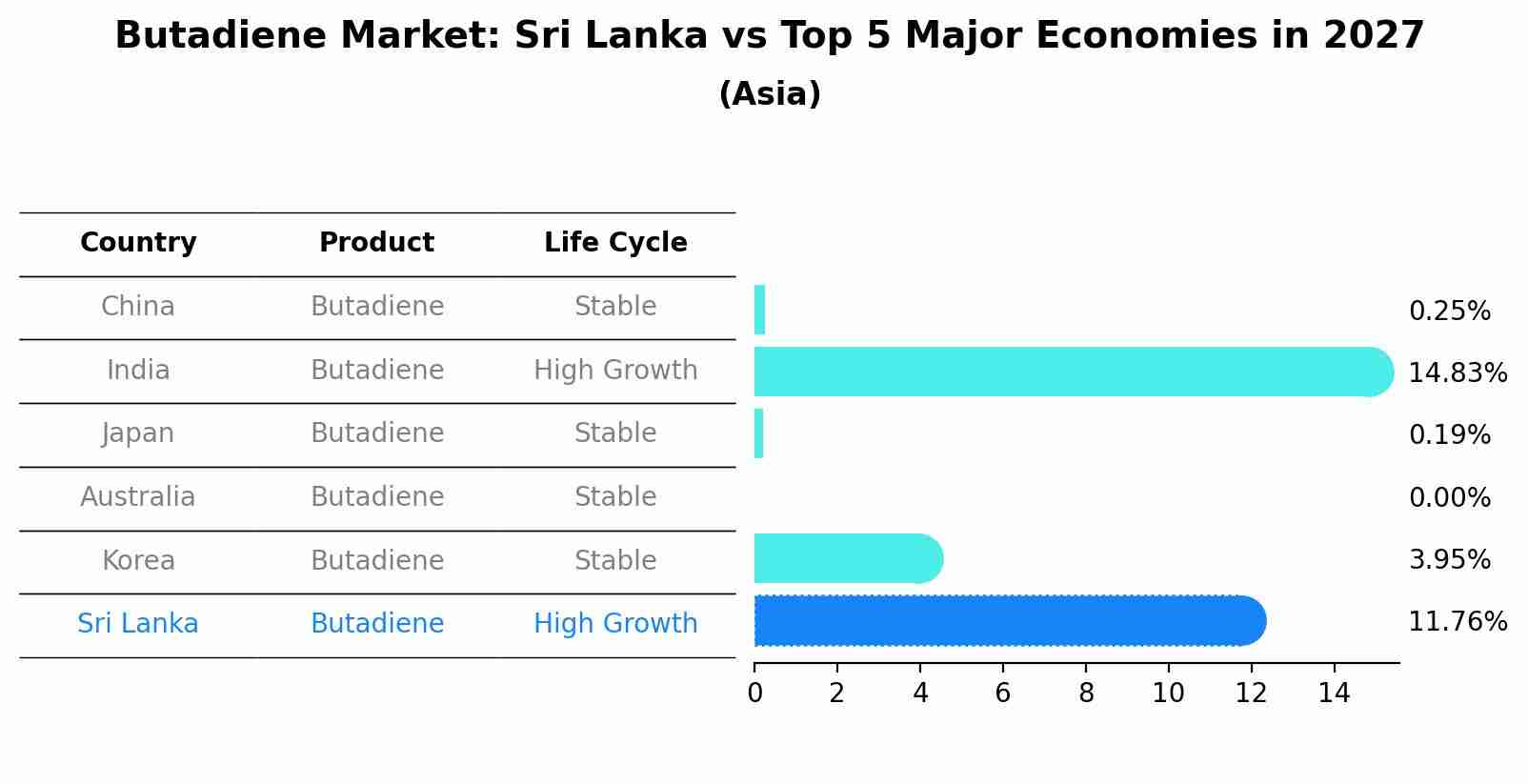Sri Lanka Butadiene Market Outlook | Forecast, Industry, Trends, Companies, Growth, Size, Share, Value, COVID-19 IMPACT, Revenue & Analysis
| Product Code: ETC109790 | Publication Date: Jun 2021 | Updated Date: Jun 2025 | Product Type: Report | |
| Publisher: 6Wresearch | Author: Bhawna Singh | No. of Pages: 70 | No. of Figures: 35 | No. of Tables: 5 |
Sri Lanka Butadiene Market Size Growth Rate
The Sri Lanka Butadiene Market is projected to witness mixed growth rate patterns during 2025 to 2029. The growth rate begins at 10.47% in 2025, climbs to a high of 11.88% in 2026, and moderates to 3.02% by 2029.

Butadiene Market: Sri Lanka vs Top 5 Major Economies in 2027 (Asia)
The Butadiene market in Sri Lanka is projected to grow at a high growth rate of 11.76% by 2027, within the Asia region led by China, along with other countries like India, Japan, Australia and South Korea, collectively shaping a dynamic and evolving market environment driven by innovation and increasing adoption of emerging technologies.

Sri Lanka Butadiene Market Overview
The Sri Lanka butadiene market is witnessing steady growth driven by increasing demand from key end-use industries such as automotive, rubber, and plastics. Butadiene, a key chemical used in the production of synthetic rubber and various polymers, is experiencing robust demand due to the expanding automotive sector and growing construction activities in the country. Additionally, the government`s focus on infrastructure development is further fueling the demand for butadiene-based products. Despite facing challenges such as fluctuating raw material prices and environmental regulations, the market is expected to continue its growth trajectory in the coming years. Key players in the Sri Lanka butadiene market are focusing on strategic partnerships and investments in research and development to stay competitive in the market.
Sri Lanka Butadiene Market Trends
The Sri Lanka Butadiene market is experiencing steady growth due to increasing demand from industries such as automotive, rubber, and plastics. The rising use of Butadiene in the production of synthetic rubber, which is widely utilized in tire manufacturing, is a key driver of market growth. Additionally, the expanding construction sector in Sri Lanka is contributing to the demand for Butadiene-based products like Styrene Butadiene Rubber (SBR) for applications in infrastructure and building materials. Market players are focusing on strategic partnerships and investments in research and development to introduce innovative products and enhance their market presence. Sustainability and environmental concerns are also influencing the market, leading to a shift towards bio-based Butadiene production methods to reduce carbon footprint and meet regulatory requirements.
Sri Lanka Butadiene Market Challenges
In the Sri Lanka Butadiene market, some key challenges are the fluctuating prices of raw materials, such as crude oil and natural gas, which impact the production costs of Butadiene. Additionally, the market faces competition from imported Butadiene products, which can be cheaper due to economies of scale enjoyed by foreign manufacturers. Limited domestic production capacity and technological constraints also hinder the growth of the Butadiene market in Sri Lanka. Furthermore, regulatory hurdles and compliance requirements pose challenges for market players in terms of meeting quality standards and environmental regulations. Overall, the Sri Lanka Butadiene market struggles with price volatility, competition from imports, capacity constraints, and regulatory complexities, which collectively impact the growth and profitability of the industry.
Sri Lanka Butadiene Market Investment Opportunities
In the Sri Lankan butadiene market, there are several investment opportunities available for potential investors. With the country`s growing industrial sector and increasing demand for synthetic rubber and plastics, investing in butadiene production or distribution could be lucrative. Partnering with local manufacturers to supply butadiene as a raw material could also be a viable option. Additionally, investing in research and development for new applications of butadiene in industries such as automotive, construction, and packaging could provide long-term growth prospects. Furthermore, considering the country`s strategic location along key shipping routes, establishing a butadiene trading business could leverage Sri Lanka`s position as a regional trading hub. Overall, the Sri Lankan butadiene market presents diverse investment opportunities for those looking to tap into the country`s growing industrial landscape.
Sri Lanka Butadiene Market Government Policy
The Sri Lankan government has implemented various policies to regulate and promote the Butadiene market in the country. These policies include setting import tariffs and quotas to control the inflow of Butadiene products, ensuring compliance with quality standards and environmental regulations to safeguard public health and the environment, and providing incentives for local production and investment in the Butadiene industry. Additionally, the government focuses on fostering research and development initiatives to enhance the competitiveness and sustainability of the Butadiene market. Overall, these policies aim to create a conducive business environment, stimulate growth in the Butadiene sector, and contribute to the overall economic development of Sri Lanka.
Sri Lanka Butadiene Market Future Outlook
The future outlook for the Sri Lanka Butadiene Market appears promising, driven by the increasing demand from various end-use industries such as automotive, construction, and packaging. The market is expected to witness steady growth due to the rising investments in infrastructure projects and the expanding manufacturing sector in the country. Additionally, the growing trend towards the production of synthetic rubber and plastics is anticipated to further boost the demand for Butadiene. However, factors such as fluctuating raw material prices and environmental regulations may pose challenges to market growth. Overall, with the increasing industrial activities and favorable government policies supporting the chemical industry, the Sri Lanka Butadiene Market is likely to experience positive growth in the coming years.
Key Highlights of the Report:
- Sri Lanka Butadiene Market Outlook
- Market Size of Sri Lanka Butadiene Market, 2021
- Forecast of Sri Lanka Butadiene Market, 2027
- Historical Data and Forecast of Sri Lanka Butadiene Revenues & Volume for the Period 2018 - 2027
- Sri Lanka Butadiene Market Trend Evolution
- Sri Lanka Butadiene Market Drivers and Challenges
- Sri Lanka Butadiene Price Trends
- Sri Lanka Butadiene Porter's Five Forces
- Sri Lanka Butadiene Industry Life Cycle
- Historical Data and Forecast of Sri Lanka Butadiene Market Revenues & Volume By Application Type for the Period 2018 - 2027
- Historical Data and Forecast of Sri Lanka Butadiene Market Revenues & Volume By Butadiene Rubber for the Period 2018 - 2027
- Historical Data and Forecast of Sri Lanka Butadiene Market Revenues & Volume By Styrene Butadiene Rubber for the Period 2018 - 2027
- Historical Data and Forecast of Sri Lanka Butadiene Market Revenues & Volume By Acrylonitrile Butadiene Rubber for the Period 2018 - 2027
- Historical Data and Forecast of Sri Lanka Butadiene Market Revenues & Volume By Nitrile Butadiene Rubber for the Period 2018 - 2027
- Historical Data and Forecast of Sri Lanka Butadiene Market Revenues & Volume By Styrene Butadiene Latex for the Period 2018 - 2027
- Historical Data and Forecast of Sri Lanka Butadiene Market Revenues & Volume By Hexamethylenediamine for the Period 2018 - 2027
- Historical Data and Forecast of Sri Lanka Butadiene Market Revenues & Volume By Others for the Period 2018 - 2027
- Historical Data and Forecast of Sri Lanka Butadiene Market Revenues & Volume By End Use Type for the Period 2018 - 2027
- Historical Data and Forecast of Sri Lanka Butadiene Market Revenues & Volume By Plastic and Polymer for the Period 2018 - 2027
- Historical Data and Forecast of Sri Lanka Butadiene Market Revenues & Volume By Tire and Rubber for the Period 2018 - 2027
- Historical Data and Forecast of Sri Lanka Butadiene Market Revenues & Volume By Automobile for the Period 2018 - 2027
- Historical Data and Forecast of Sri Lanka Butadiene Market Revenues & Volume By Chemical for the Period 2018 - 2027
- Historical Data and Forecast of Sri Lanka Butadiene Market Revenues & Volume By Others for the Period 2018 - 2027
- Sri Lanka Butadiene Import Export Trade Statistics
- Market Opportunity Assessment By Application Type
- Market Opportunity Assessment By End Use Type
- Sri Lanka Butadiene Top Companies Market Share
- Sri Lanka Butadiene Competitive Benchmarking By Technical and Operational Parameters
- Sri Lanka Butadiene Company Profiles
- Sri Lanka Butadiene Key Strategic Recommendations
Frequently Asked Questions About the Market Study (FAQs):
- Single User License$ 1,995
- Department License$ 2,400
- Site License$ 3,120
- Global License$ 3,795
Search
Thought Leadership and Analyst Meet
Our Clients
Related Reports
- Canada Oil and Gas Market (2026-2032) | Share, Segmentation, Value, Industry, Trends, Forecast, Analysis, Size & Revenue, Growth, Competitive Landscape, Outlook, Companies
- Germany Breakfast Food Market (2026-2032) | Industry, Share, Growth, Size, Companies, Value, Analysis, Revenue, Trends, Forecast & Outlook
- Australia Briquette Market (2025-2031) | Growth, Size, Revenue, Forecast, Analysis, Trends, Value, Share, Industry & Companies
- Vietnam System Integrator Market (2025-2031) | Size, Companies, Analysis, Industry, Value, Forecast, Growth, Trends, Revenue & Share
- ASEAN and Thailand Brain Health Supplements Market (2025-2031) | Strategy, Consumer Insights, Analysis, Investment Trends, Opportunities, Growth, Size, Share, Industry, Revenue, Segments, Value, Segmentation, Supply, Forecast, Restraints, Outlook, Competition, Drivers, Trends, Demand, Pricing Analysis, Competitive, Strategic Insights, Companies, Challenges
- ASEAN Bearings Market (2025-2031) | Strategy, Consumer Insights, Analysis, Investment Trends, Opportunities, Growth, Size, Share, Industry, Revenue, Segments, Value, Segmentation, Supply, Forecast, Restraints, Outlook, Competition, Drivers, Trends, Demand, Pricing Analysis, Competitive, Strategic Insights, Companies, Challenges
- Europe Flooring Market (2025-2031) | Outlook, Share, Industry, Trends, Forecast, Companies, Revenue, Size, Analysis, Growth & Value
- Saudi Arabia Manlift Market (2025-2031) | Outlook, Size, Growth, Trends, Companies, Industry, Revenue, Value, Share, Forecast & Analysis
- Uganda Excavator, Crane, and Wheel Loaders Market (2025-2031) | Strategy, Consumer Insights, Analysis, Investment Trends, Opportunities, Growth, Size, Share, Industry, Revenue, Segments, Value, Segmentation, Supply, Forecast, Restraints, Outlook, Competition, Drivers, Trends, Demand, Pricing Analysis, Competitive, Strategic Insights, Companies, Challenges
- Rwanda Excavator, Crane, and Wheel Loaders Market (2025-2031) | Strategy, Consumer Insights, Analysis, Investment Trends, Opportunities, Growth, Size, Share, Industry, Revenue, Segments, Value, Segmentation, Supply, Forecast, Restraints, Outlook, Competition, Drivers, Trends, Demand, Pricing Analysis, Competitive, Strategic Insights, Companies, Challenges
Industry Events and Analyst Meet
Whitepaper
- Middle East & Africa Commercial Security Market Click here to view more.
- Middle East & Africa Fire Safety Systems & Equipment Market Click here to view more.
- GCC Drone Market Click here to view more.
- Middle East Lighting Fixture Market Click here to view more.
- GCC Physical & Perimeter Security Market Click here to view more.
6WResearch In News
- Doha a strategic location for EV manufacturing hub: IPA Qatar
- Demand for luxury TVs surging in the GCC, says Samsung
- Empowering Growth: The Thriving Journey of Bangladesh’s Cable Industry
- Demand for luxury TVs surging in the GCC, says Samsung
- Video call with a traditional healer? Once unthinkable, it’s now common in South Africa
- Intelligent Buildings To Smooth GCC’s Path To Net Zero


















